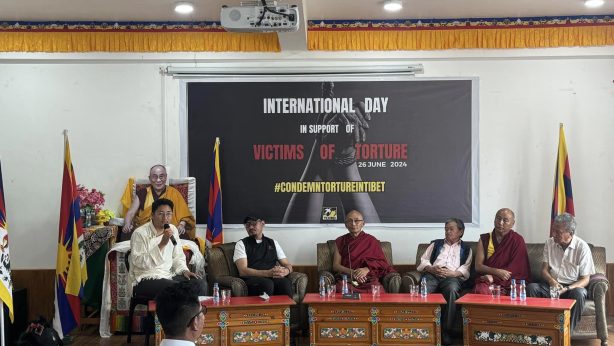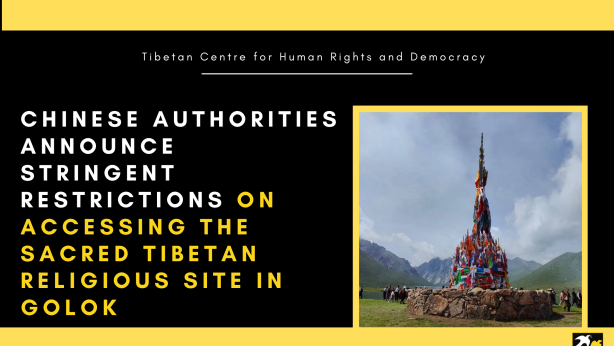Mao’s legacy in Tibet
 On 26 December 2013, China held a grand celebration to commemorate the 120th birthday of Mao Zedong (毛澤東). This involves a careful balance for Xi Jinping and other members of the Chinese Communist Party, who hope to exploit Mao Zedong’s rhetoric and status without endorsing his policies or ideology, both of which are contrary to the PRC’s current policies and announced reforms.
On 26 December 2013, China held a grand celebration to commemorate the 120th birthday of Mao Zedong (毛澤東). This involves a careful balance for Xi Jinping and other members of the Chinese Communist Party, who hope to exploit Mao Zedong’s rhetoric and status without endorsing his policies or ideology, both of which are contrary to the PRC’s current policies and announced reforms.
In Tibet, there is no contradiction between Mao Zedong’s legacy and his policies. Both were brutal and led to mass arrests, death, and destruction in Tibet. While the PRC quietly distanced itself from some of Mao Zedong’s worst policies after his death in 1976, many continue to cast a shadow over Tibet.
For the next 26 years since PRC’s invasion of Tibet in 1949, Tibetans were subjected to horrific, inhumane conditions. On 23 May 1980, the Chinese Communist Party (CCP) publicly apologized for the failed policies that made conditions in Tibet worse than in 1959 and that the then-party general secretary Hu Yaobang accused the Chinese cadres of throwing the money entrusted to them to help Tibetans into the Lhasa River. Despite this acknowledgement, many of the most brutal and destructive policies from Mao’s rule still continue today.
Most importantly, Mao Zedong was responsible for the invasion of Tibet in 1949. Before the Chinese invasion, Tibet was an independent, neighboring state that had aided Mao Zedong and his fledgling fellow communists during the Long March. During the Chinese invasion, thousands of Tibetans died as they attempted to flee from the People’s Liberation Army.
Tibetans are subjected to mass arrests based on fictitious charges. Like when Mao was alive, arrested Tibetans are tortured. The most notorious method of torture from the 1950s, still in practice today in Tibet, is the use of positional torture techniques. These involve, among other things, tying a detainee’s hands behind his back and then suspending the detainee from the ceiling. Often Tibetans are subjected to torture during “interrogation” sessions where their inquisitors ask the same questions they have for over 60 years. Like under Mao Zedong, the PRC is convinced that the spontaneous protests against the Chinese government are instigated and organized by the “Dalai clique” or “hostile foreign forces”. In the 37 years since Mao Zedong’s death Chinese officials still fail to recognize that ordinary Tibetans are not happy with PRC’s policies and treatment.
When Mao Zedong ruled the PRC he created forced labor camps both as a judicial and extra-judicial form of punishment based on the former Soviet Union’s gulags. Referred to as Reform Through Labor (Ch: laogai) and Re-education Through Labor (Ch: laojiao) respectively, by the time the PRC celebrates Mao Zedong’s birthday both of these infamous, antiquated, and brutal methods of punishment will still exist in the PRC. Only recently, has the PRC pledged to abolish Re-education Through Labor. Today, the detainees in the PRC’s forced labor camps are fed black tea and watery vegetable soup, so diluted the vegetables do not add any flavor to the water. This is the same diet the prisoners ate when tens of millions of Tibetans and Chinese were starving to death during the man-made “Great Chinese Famine.” Now, with Mao’s birthday celebrations some in the PRC are attempting to turn one of these spectacular disasters that defined Mao Zedong’s time as president of China, into a less dramatic event by claiming that “only” millions of people starved to death.
In Tibet, the worst part of Mao Zedong’s rule was when the Cultural Revolution plunged “Tibet into the deepest hell.” During the Cultural Revolution, Mao Zedong encouraged people to destroy the “Four Old”: old customs, habits, beliefs and ideas. This threw all of the PRC into chaos but was felt particularly hard in Tibet, which can trace its society back to thousands of years. Irreplaceable ancient medical and religious texts were destroyed. Religious symbols were publicly destroyed and then the remnants were blown up. Sacred wooden blocks were turned into farming implement. The sayings of Mao Zedong were carved into mountainsides over Buddhists prayers. The Cultural Revolution ended with Mao Zedong’s death in 1976. By the end of the Cultural Revolution more than 6,000 monasteries had been destroyed, only 12 were left standing. In short, Mao attempted to take the Buddha’s place as ‘god’ in Tibet. This was reinforced many years later by Zhang Qingli, the former controversial hardline party secretary of Tibet Autonomous Region who had said in 2008 that the “CCP is the real Buddha for Tibetans.”
Mao Zedong’s policies were not only the direct cause of the invasion of Tibet, the starvation of the Tibetan people, and destruction of Tibetan Buddhist relics. Mao Zedong’s policies also set the precedent for the dismal human rights abuses that are still occurring in Tibet today. As the PRC begins to implement reforms and move away from Mao Zedong’s actual policies in the PRC, it should also abandon those policies in Tibet, where, over the past 64 years, they have proven destructive and ineffective.
Endnotes
1. China marks Mao Zedong’s 120th birthday anniversary http://www.bbc.co.uk/news/world-asia-china-25518017
2. https://diogenesii.wordpress.com/tag/tibet/
3. Melvyn C. Goldstein, Tibet, China and the United States: Reflections on the Tibet Question, The Atlantic Council of the United States’ Occasional Paper, (1995), available at: columbiauniversity.net/itc/ealac/barnett/pdfs/link4-goldstn.pdf. Mar Jang-nyug, “Ancestors’ Tomb,” Tibetan Centre for Human Rights and Democracy, available at: https://tchrd.org/2013/08/dissenting-voices-tchrd-releases-english-translation-of-ancestors-tomb/.
4. Palden Gyatso, FIRE UNDER THE SNOW, (2010) at 74.
5. http://www.nytimes.com/2013/10/17/world/asia/advancing-a-milder-version-of-maos-calamities.html?_r=0.
6. http://www.foreignpolicy.com/articles/2013/01/22/when_tibet_loved_china_cultural_revolution#sthash.JzaxAdbN.dpbs (photo gallery from Woeser published by Foreign Policy Magazine).
7.The True Story of Maoist Revolution in Tibet http://www.revcom.us/a/firstvol/tibet/tibet3.htm.
8.http://teachers.guardian.co.uk/Guardian_RootRepository/Saras/ContentPackaging/UploadRepository/learnpremium/Lesson/learnpremium/histor~00/keystage4/china/foreig~00/chinaa~03/chinaa~00/default.htm


